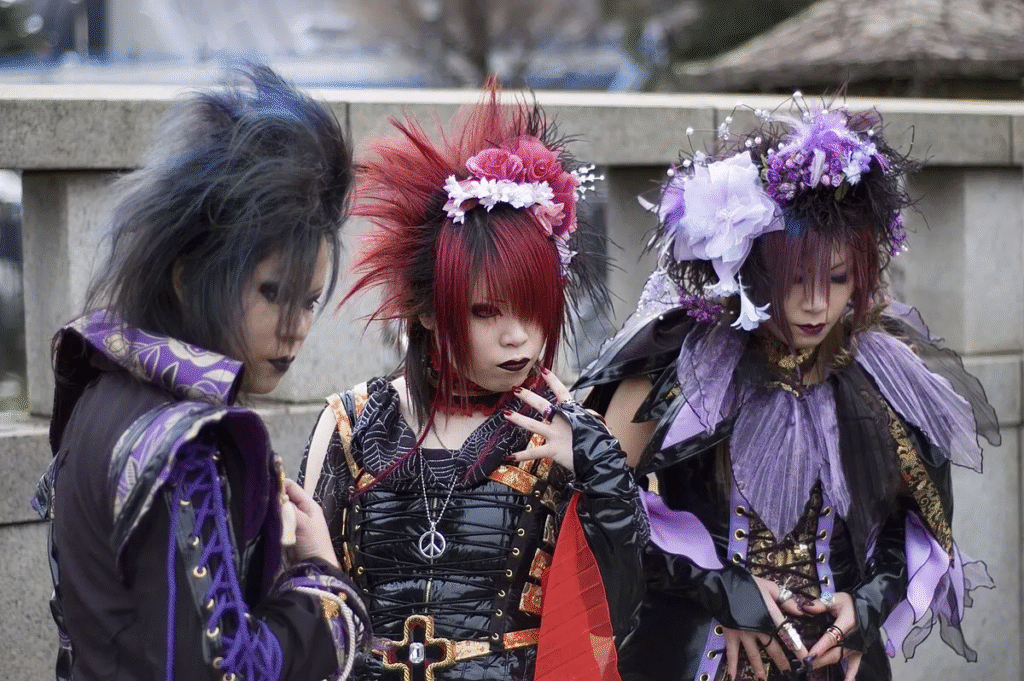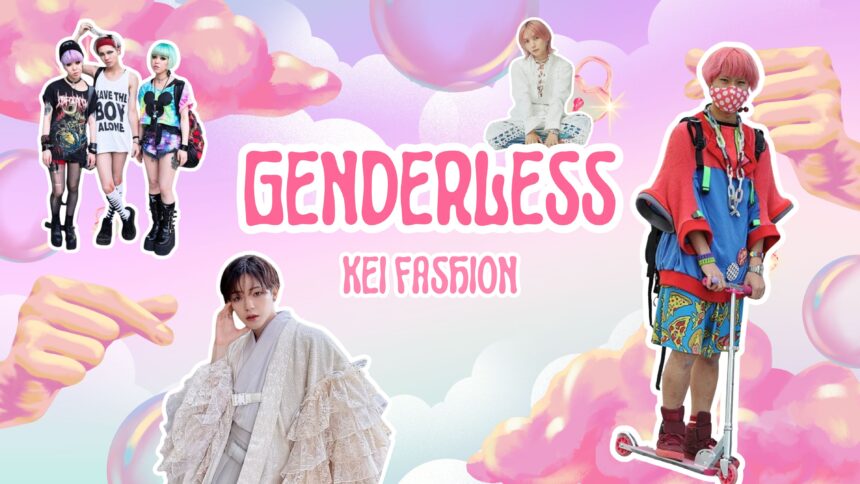Japan may be famous for its food, scenery, and historical landmarks. However, ask any 90s kid where they’d like to visit the most, and many of them will tell you: Harajuku. the site of a number of fashion trends, including the eye-catching “Visual Kei.”
While you may be familiar with this aesthetic (or, at the very least, the term), you may not be so aware of how it has shifted to become a part of LGBTQ+ culture in Japan. So today, we’re going to be discussing Genderless Kei Fashion.
What is Visual Kei?

Visual Kei (ビジュアル系), translated as “visual style,” is a form of fashion aesthetic birthed in the late 1980s and early 1990s in Japan. Taking inspiration from glam rock and heavy metal, Visual Kei is characterized by extravagance in terms of both costume and hair style.
Visual Kei has long been associated with music, and arguably the origin of the look can be traced back to the band X Japan, and its then guitarist, Hide. It influenced the look of bands such as L’Arc En Ciel, Glay, and Luna Sea in the 1990s, with the 2000s seeing the emergence of “neo Visual Kei,”where bands outside of the pop-rock genre began to adopt the aesthetic.
Although Visual Kei is not strictly gendered, many of those who follow the style are, and were, men. So, how did Genderless Kei come about?
What is Genderless Kei?

Visual Kei itself, as mentioned, is not specifically gendered, however the majority of those who indulge tend to be men, thus giving it a somewhat masculine image in the public mind. However, the growth of Genderless Kei (ジェンダーレス系) can be traced back a decade ago, when non-binary and agender models appeared in the 2015 Autumn/Winter Tokyo Girls Collection fashion show.
The term is used today to describe an androgynous form of Visual Kei: being flashy, extravagant, and eye-catching, but without being couched in masculine signifiers. Instead, it reflects delicacy and feminine beauty in AMAB people, while AFAB people tend to instead portray their masculine attributes.
This means that those who partake in Genderless Kei tend to gravitate to items of clothing that would typically be the preserve of their birth gender. For example, AMAB people usually gravitate to pinks and lighter clothing, while AFAB people might prefer heavier clothing or suit jackets, and darker colors.
Key Aspects of Genderless Kei
Here are a few basics for Genderless Kei styles.
Clothing

As mentioned above, you will want to be wearing clothing that goes against what society would generally consider to be acceptable for the gender you were assigned at birth. This can be both in terms of colors, and in terms of the kind of clothing one wears.
Hairstyling

Hair is often, though not exclusively, heavily styled using product to keep spikes or bangs in place. Additionally, dye is often used for extraordinary colors, emphasizing the individuality of the Genderless Kei person.
Accessories

Cuteness is the name of the game when it comes to accessories. These are often made up of adorable hats, purses, bags, and nail Polish or acrylics. These, naturally, go for both AMAB and AFAB people.
Who Usually Engages in Genderless Kei?
Although Genderless Kei is for anyone who wants to use fashion to critique or rebel against the rigid gender rules imposed by patriarchy, both in Japan and abroad, it is currently typically indulged in by AMAB people. There is even a term specifically for people who are AMAB and enjoy Genderless Kei: “neo ikemen,” or “neo handsome boys.”
Interestingly, despite the obvious appeal to the LGBTQ+ community in particular (given the obvious reasons to dislike patriarchy, especially in conservative Japan), many of the people involved in Genderless Kei fashion are straight, and/or identify with the typical gender binary. As such, the people who are engaged in Genderless Kei are diverse and accepting of newcomers.
Here are some people associated with the Genderless Kei aesthetic:
- GENKING Instagram
- Yohji Kondo Instagram
- Toman Instagram
- Ryucheru Instagram
- Pey Instagram
- Shoshipoyo Instagram
- Satsuki Nakayama Instagram
- Satoyupi
- Yusuke Hida
- Kanata
- Sakupan
No matter your sexuality or gender — or, indeed, lack thereof — Genderless Kei gives you an opportunity to dress the way you want to. It’s always important for sexual minorities to be visible, and this is one way to be both visible and visual.

